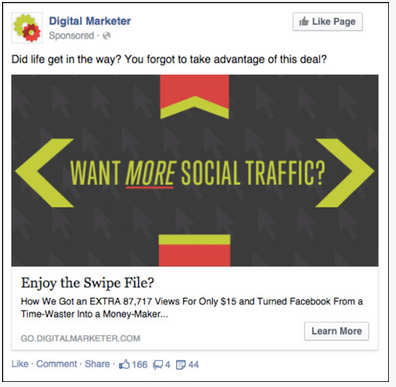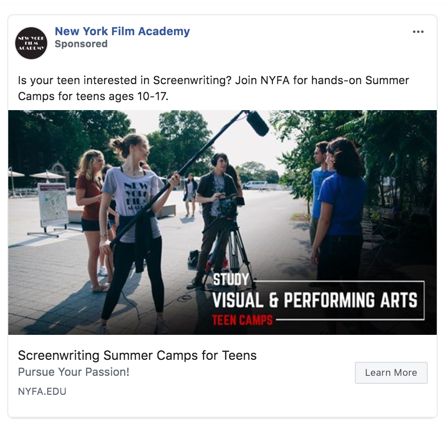Why it’s important to do Facebook retargeting ads


Have you ever been on the verge of buying a product online when some outside interruption steals your attention away? Yeah, us too. It turns out even if we see the value in a product and intend on buying it, the tendency is to think, “Oh, I’ll just buy it later.” And then later never comes.
In fact, a 2019 study found the average e-commerce shopping cart abandonment rate is a whopping 69.57%!
That’s insanely high. It means nearly 7 out of 10 people left the checkout process after adding a product to their cart. Over the course of a year, that adds up to a mighty large chunk of change that’s slipped through the cracks.
So, what can you do about it?
Retarget the market
Google calls it “remarketing.” Facebook calls it “retargeting.”
There are other terms for it, but the idea is the same: it’s an advertising technology that allows you to plug those leaks in your bucket and win back sales you would have otherwise lost for good.
Because this article focuses on Facebook, we’ll use the term “retargeting.”
These retargeting ads came a long way over the past ten years, and they are much more sophisticated than most people realize.
Most people know of the retargeting Amazon employs. You’ve seen it firsthand, no doubt. Think of that time you added a pair of sneakers to your shopping cart, forgot to finish buying them, and then an ad showing those exact same sneakers followed you around the internet for the next few days.
You know what? Those ads work like crazy.
Retargeting ads might be one of the easiest ways to boost your business’s ROI, helping you snag extra sales which you may have otherwise lost.
There are other uses for retargeting, too. And although we can’t dive into all the possibilities available with retargeting in this article, it’s still good to know some of the other major benefits:
1. Take the stage
Getting in front of new people is critical to any business.
But too often, even if a business does reach someone new, they fail to follow up. Which is not good, because every marketing pro knows it takes multiple follow-ups to convert the sale.
Retargeting gives you a second chance (and many more) to seal the deal.
2) Deliver personalized content
Most retargeting tools allow you to slice and dice your audiences into multiple segments, depending on what they’re interested in or an action they’ve recently taken.
For example, you can run ads to people who registered for an upcoming webinar, who recently opted-in to your email list, or watched that new video you posted to your Facebook page.
Retargeting allows you to deliver the perfect message at the perfect time.
3) Turbocharge your marketing campaigns
Got a big launch coming up? Simple retargeting gives you the power to amplify your efforts and increase your revenue. A smart retargeting strategy can be the thing that helps you shatter your previous revenue record for launches.
How Facebook retargeting works
Before diving deeper into the technology side, it’s important to first understand the different types of audiences (a.k.a. traffic) you can reach on Facebook.
Audiences you can create and target with Facebook ads
Cold traffic
In short, cold traffic represents new people who have yet to interact with your business.
There are three main categories of cold traffic on Facebook:
-
Demographics (age, gender, geography, profession, etc.)
-
Interests (other pages people like on Facebook, topics they comment on, etc.)
-
Lookalikes (a cold audience based on a smaller “seed” warm audience, such as your website visitors)
Cold audiences can be massive, often in the millions of people. Unless you run a large company with tons of web traffic, they’re typically much larger than your warm audiences.
Most cold traffic is also the most expensive type of traffic to reach, which is why it’s usually best to start with warm traffic. We’ll focus on warm traffic for the remainder of this article.
Warm traffic
Warm traffic includes people already familiar with you. They’ve interacted with your business in some way, shape, or form.
Although the size of this warm pool of prospects is typically not as large as cold traffic, most online business owners have a larger warm audience than they think.
Warm traffic includes:
-
People who visit your website
-
Someone on your email list
-
People who follow your Facebook or Instagram page
-
Someone who watch a video on your Facebook or Instagram page
-
People who engage with your Facebook or Instagram page
(This list is always evolving, with more audiences consistently being added to the fold, so it’s best to refer to Facebook’s help article on the topic for an up-to-date list.)
Within Facebook, these audiences are referred to as custom audiences. We’re willing to bet when you add up all these audiences for your own business, you’ll have a larger pool of people in your custom audiences than you think.
The tech side of retargeting: The Facebook Pixel
You’ve probably heard of the Facebook Pixel before. Just so we cover our bases, the Facebook Pixel is an analytics and tracking tool. It allows you to monitor and measure how effective your advertising is doing by understanding how your traffic behaves on your website.
Still not sure what that means? Here’s a quick rundown of the different ways the term is used:
It’s used as a noun: “We installed the pixel on our website.”
It’s used as a verb: “We pixel everyone who visits our website.”
Additionally, it’s used as an adjective: “Our pixeled audience is 100,000 people.”
Now that we’ve put it into context, hopefully it’s clear to you what the Facebook Pixel does. At its core, it tracks people who visit your website.
The pixel serves many functions, but for our purposes, we’re going to talk about it in the context of retargeting.
How your readers get pixeled
Say you install the pixel on every page on your website (which you should do, as you don’t want to miss out on pixeling a single person). When someone visits one of your pages, the pixel stays attached to the visitor—even when they leave your website.
What actually happens is a small file called a “cookie” is added to the user’s browser, which tracks them across the web. This allows you to track down those previous visitors and follow up with them across the internet using Facebook ads.
(Note: For a full, up-to-date list of where people can see your Facebook ads, visit this article.)
Luckily, it’s not only your website visitors who you’re able to pixel. Remember that warm audience list above? It included people on Facebook and Instagram. That’s because you’re not limited to pixeling only website visitors.
Here are a few different examples to help demonstrate how this works.
1. A person being pixeled after visiting your website.
2. Someone being pixeled after clicking “Like” on your Facebook page.
3. A person being pixeled after watching a video posted on your Instagram.
4. Someone being pixeled after joining your email list (either because you have the pixel installed on your thank you page, or because you uploaded the email addresses manually.)
Is the pixel picture becoming clearer? Good.
We have the tools, but you have the skills. Our Free Plan is the perfect place to start flexing those skills. Sign up today to share what you know (no credit card needed).
Creating custom audiences
Once people are pixeled, you must set up a custom audience inside Facebook. You can tell Facebook: “Hey Facebook, create an audience of everyone who visited my website.”
If you want to be more specific: “Facebook, create an audience which only includes people who visited any blog posts in this one specific category.”
Or, for a checkout page abandonment ad: “Facebook, create an audience of only people who visited the checkout page, but did not visit the thank you page.”
Do you see how doing this will give you that highly lucrative audience we talked about at the start of this article? Once that audience is created, it’s now available for you to deploy your retargeting ad to the people inside.
Common questions about how retargeting works
After I set up an audience, are people added to it automatically?
Yes! That’s the beauty of retargeting. You can set up the audience beforehand, so that when someone gets pixeled, they’re automatically added to the audience.
If you’re already running an ad to that existing audience, that new person who was just pixeled will begin seeing your ad the next time they visit Facebook.
(Note: An exception to this rule is when you are manually uploading contact information to Facebook. For example, if you held a free local workshop and wanted to upload the contact info of all the attendees.)
How long is someone in your audience?
The maximum is 180 days. After that, unless they take another action that causes them to be pixeled, they’ll fall out of your custom audience and stop seeing any ads you’re running to that audience.
Read more on Facebook’s official help article.
Is my visitors’ personal information kept private?
Yes, it’s kept private. You cannot see any personal information about who’s in your warm audience.
For example, if you have 10,000 people in the custom audience for your email list, you won’t see 10,000 first and last names. You’ll simply see the number “10,000” listed next to that audience title.
How do I budget for retargeting?
Your budget depends on many things; there are no one-size-fits-all rules. It depends on your audience size, your market, your location, and other factors.
Instead of giving you a hard and fast rule, we’ll give you guidelines so you can dial in the perfect budget for your business.
One excellent guidepost to help you dial in your Facebook budget is frequency. Facebook defines frequency as “the average number of times each person saw your ad.”
In other words, it answers the question: “How many times has someone seen my ad?”
You want the frequency to be high enough that your prospects actually see your message and take action on it, but not so high that they’re annoyed and burned out.
Audience size
This is where the variable of your audience size comes into play.
Imagine you have an audience of only 100 people and spend a whopping $10,000 on retargeting for the week. What’s going to happen? Well, those 100 people are going to see that ad a whole lot. That’s because $10,000 is a lot to spread among a tiny pool of 100 people.
Now, what happens if you spread that $10,000 between an audience of one million people? Each person will see the ad far fewer times.
The ideal frequency is a hotly debated topic which advertising professionals are constantly studying. We recommend that keeping the frequency in the 3-4 range works best for these retargeting ads.
You can find the frequency report in the “Columns” dropdown inside your Facebook Ads Manager account.


The great thing about retargeting, as we mentioned above, is the high ROI. You may only spend under $1 to reach someone who bailed on a shopping cart—but a purchase could be worth $100, $500, or $1,000-plus depending on the price of your product.
That’s why the “bottom-of-funnel” retargeting ad is usually the first place I recommend business owners start when they decide to kick off a paid traffic effort.
Designing your high-ROI retargeting ad
You don’t need to be highly creative or an outside-the-box thinker to be effective in your retargeting approach. Most of your success will come from simply doing it.
Remember, the people you’re most likely to convert with this ad were on the verge of purchasing anyway. They were already convinced of the value of what you’re selling. What they often need is simply a reminder.
That said, here are some guidelines for crafting an effective checkout page retargeting ad:
Messaging
The ad is where your reader picks up the scent, so to speak. If they click the ad and what they see on the landing page looks or reads nothing like the ad they initially clicked, they’ll become confused. That’s because they lost the scent. They may bail yet again—this time for good.
The lesson? Make your ad congruent with your landing page. Use similar messaging, colors, images, and tone of voice. Maintain the scent.
Here are some tips for your ad’s messaging:
- Include some kind of urgency. Why should they take action now? Is there a deadline or expiring bonus?
- Use social proof to increase conversions. Tell them how many people have purchased this product before. Include some customer quotes.
- Acknowledge their buyer journey. It’s okay to acknowledge in the copy the fact that they were about to buy, but don’t be creepy about it. A simple statement or question (e.g. “Did life get in the way?”) is enough.
- Remind them of your value proposition. What are all the great features and benefits your product provides? Make them an offer they can’t refuse.
- Give a clear, direct call to action. Tell them exactly what to do next. Don’t leave it up to them to guess. As my copywriting coach once told me, “Confusion is the death of the sale.”
Media
A Facebook ad can be split up into two parts: The text and the media (i.e. images and videos).
Here are some tips for choosing the right media:
- Customize the media for the different ad placements. This is a huge area most people overlook. That horizontal image which looks beautiful on Facebook’s desktop newsfeed is not going to be optimized for an Instagram story with its vertical orientation.
- Including a product bundle works well. A product bundle is a graphic that shows the “stuff” the customer is getting. If it’s an online course, a product bundle might show videos, worksheets, and audio files.
- Maintain the scent of the ad. As mentioned above, it’s important to stay consistent with your branding. Use the same colors, patterns, and style on your ad that you have on your landing page.
- Test text vs. no text on the image. You’ll often find one outperforms the other.
- Don’t start with video. We would keep it simple at first and start with an image, then build up to video.
Here are a few other good examples of retargeting ads we’ve come across:






Teachable’s retargeting feature
Prior to this Teachable integration, you were not able to track any behavior on your checkout page. Now, the pixel is automatically installed on all Teachable pages, including the checkout page, which means you’re finally able to run ads to those people who visited your checkout page and didn’t purchase.
With a paid plan on Teachable, you can enable the integration in your Teachable account, add in your Facebook Pixel, and monitor your ads.
Here’s what you need to do
-
Enable the integration in Settings > Integration.
-
Copy and paste your Facebook Pixel ID into the field available. Within the Facebook Pixel Code script, you should see “fbq(‘init’, ‘XXXXXXXXXXX’);”. The string of numbers is what you need.
-
Save the Pixel ID.
-
Remove any event code from Thank You pages if you’ve added it in before. While it won’t mess reporting up, the pixel will be more accurate.
-
To make sure the pixel is installed, we recommend installing the Facebook Pixel Helper plugin for the Chrome browser.
-
After it’s installed, visit any Teachable-hosted page. If the pixel is installed and working correctly, the plugin light up green. That means you’re good to go! You can begin creating Facebook custom audiences based off people who visited your school and run ads to those audiences.
Haven’t created a Facebook Pixel yet? Here are some helpful articles on how to do so with an individual or a Facebook Business account.
Your Turn
Remember, using Facebook Ads is a long-term strategy. Start small, conduct tests, read the data, and make improvements. If your ad isn’t working right out of the gate, that’s okay! Many ads don’t. But the beauty of digital advertising is your ability to quickly iterate and test your way to profitability.